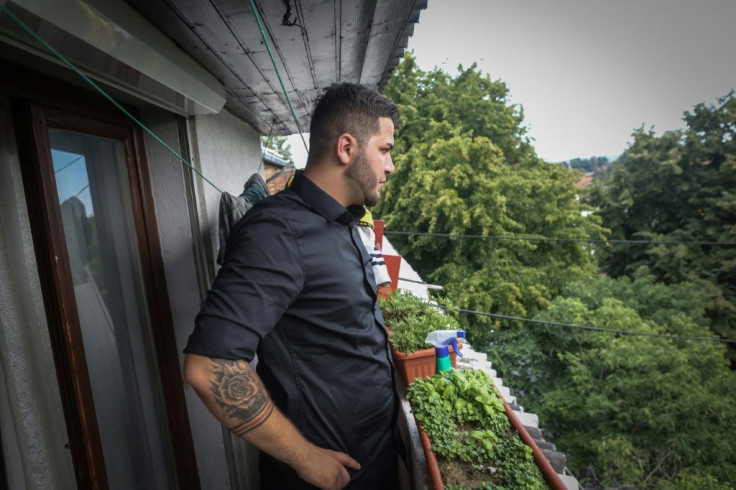Childhood Packed In A Rucksack: Young Refugees At Risk In The Balkans
A group of boys sit on a sunny patch of grass in a park in downtown Belgrade, but they are not here for a picnic.
They are "unaccompanied minors" -- the official name for the most vulnerable category of migrants who travel thousands of miles without adult supervision -- and they came to meet a smuggler to ferry them across the next border.
Although the so-called Balkan route was officially closed in the wake of Europe's migrant crisis five years ago, the region is seeing a fresh tide of travellers, even amid the coronavirus pandemic.
Some 30,000 refugees and migrants were registered in Serbia in the first half of 2020, almost three times the number for the same period last year, according to official data.
Among them, 1,200 are minors travelling alone, the youngest at just seven years old.

In the Belgrade park, a green-eyed 14-year-old from Afghanistan describes leaving home in February after the Taliban took his father, two older brothers and two uncles to the mountains and killed them.
"My mother decided that I had to go," Ahmed, whose name was changed for this story, told AFP.
Since then, he has travelled more than 4,000 km (2,500 miles) across five borders, mostly on foot.
"When we crossed from Afghanistan to Iran, we took the mountain route. It was snowing, and 12 people from our group froze to death," the child recalled, with a trembling voice.

Youngsters like Ahmed face myriad dangers on the migrant trail, which involves linking up with smugglers, evading border police and finding places to sleep in foreign cities.
Almost a third of unaccompanied children passing through Serbia have experienced violence -- either physical, psychological or sexual, according to data from Doctors Without Borders (MSF).
They describe "blackmail, torture or rape, mostly during the trail," former MSF psychologist Natasa Toskic told AFP.
The majority of the children Toskic worked with had developed issues like anxiety, depression, substance abuse and behavioural problems such as self-harming.

"The percentage of those who developed PTSD is larger than the ones that didn't," she said.
Official refugee camps can be dangerous too.
After Serbia went into lockdown to battle the coronavirus earlier this year, it sealed migrant centres shut.
In June, a video emerged showing security guards slapping and beating minors with batons in Bogovadja camp, a site which has only one social worker for 330 children.
In March, six adult migrants were arrested in a centre in Bosnia on suspicion of raping several teenagers in the camp.

Linking the Middle East to Europe, the Balkans became a thoroughfare for migrants in 2015, when hundreds of thousands flowed through the region in hopes of reaching Western Europe.
The route was shuttered under a 2016 agreement between the European Union and Turkey, which agreed to house the refugees in return for 6 billion euros in aid.
But traffickers continue to carve paths through the peninsula, crossing seas, rivers and mountains, and often packing up to 20 migrants in a single vehicle.
As a hub for smugglers, Belgrade remains a major intersection, from which trails branch out towards neighbouring Croatia, Bosnia and Hungary.
Smuggler fees range up to $10,000, often putting families in huge debt, said Vladimir Sjekloca, of the NGO Crisis Response and Policy Centre.
"They can only pay a small amount of the needed money to the traffickers," effectively leaving the youngsters "in a form of slavery".
All of the children AFP spoke to also described violent police pushbacks -- forced expulsions without the chance to apply for asylum -- at the borders, which Balkan countries deny or treat as one-off "incidents".
Most of the pushbacks were carried out by Hungarian and Croatian police, according to testimonies gathered by the Border Violence Monitoring Network, a regional NGO.
In 2020 alone, there have already been 40 reported assaults on groups that had minors among them, including a five-month-old baby, the NGO reports.
Karox Pishtewan, a Kurdish refugee who came to Serbia three years ago as a "scared to death" 16-year-old, has taken a different route to most.
After years in a Serbian orphanage, he decided to stay and was one of the few to secure refugee status here.
Today the 19-year-old sports a trimmed beard and has an apartment of his own in Belgrade, plus a job as a translator for a human rights NGO.
"Here I don't have too much, but I have a life," he said in Serbian, adding that he often tries to persuade other youngsters from continuing onwards.
When Pishtewan first entered Serbia, the Balkan country was receiving praise for a more humanitarian reception of migrants compared to neighbours who erected border fences and pushed xenophobic rhetoric.
But migrants have increasingly become a target of far-right groups, who accuse the government of a "secret plan" to settle hundreds of thousands in Serbia, a claim denied by the government.
Most children think only of getting to their desired destination.
"I know this is not something a 14-year-old is supposed to experience," said Ahmed, who said he wanted to reach France.
"But I didn't have a choice. There is death on the route, but death is also at home, it makes no difference."
© Copyright AFP 2024. All rights reserved.





















